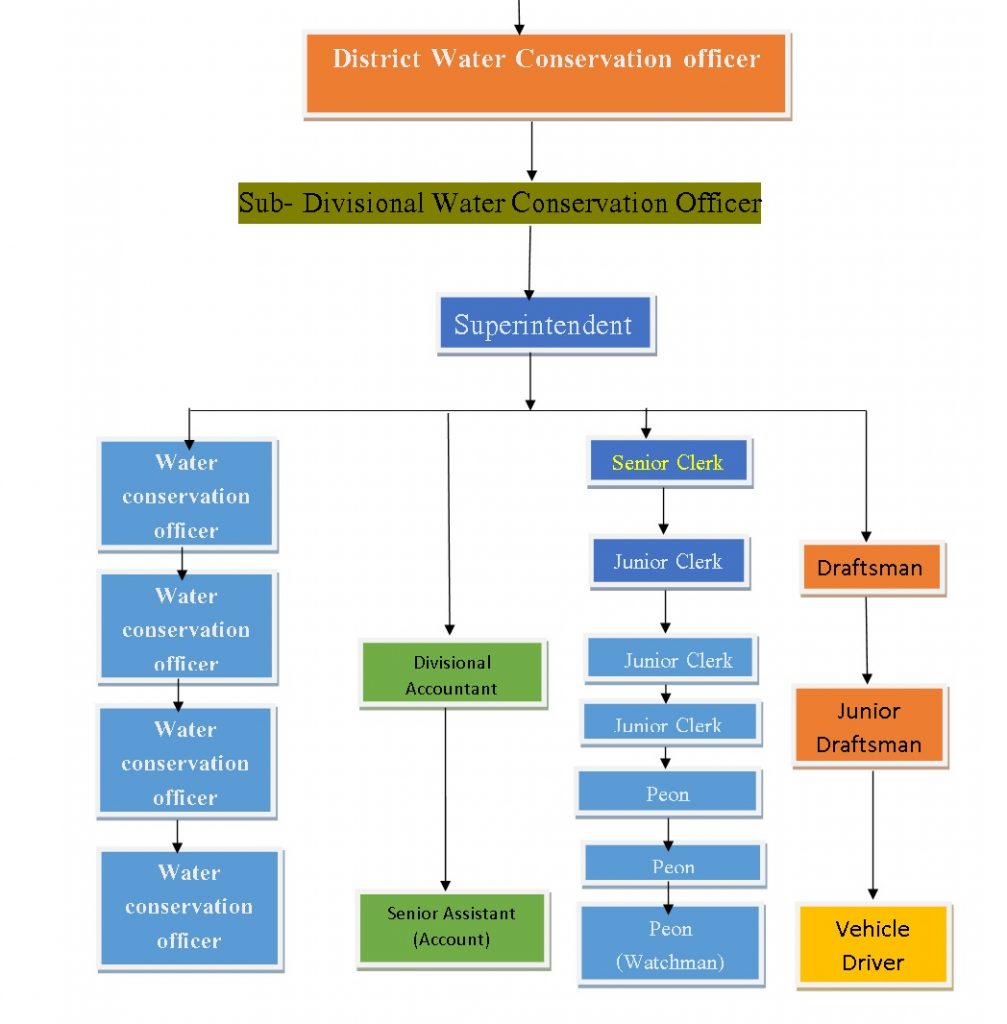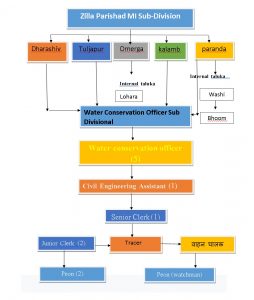Introduction
80 percent of the agriculture in Dharashiv district is dependent on the rain water, and now the amount of rain is decreasing and the rain water is flowing away, the works of the minor irrigation department have become very important. Under the Minor Irrigation Department, the works ranging from 0.00 to 100.00 hectares of irrigation capacity are completed in a short period of time, thereby benefiting the farmers quickly. It generally involves the construction and maintenance of village ponds / seepage ponds / irrigation / storage ponds, construction of Kolhapur style dams and cement drain dams etc.
Also construction and repair works of minor irrigation from 0 to 100 hectares of irrigation capacity are done through Zilla Parishad under various heads. For this, there is a minor irrigation department in Dharshiv Zilla Parishad, and the minor irrigation works in all talukas of the district are done through Dharashiv, Tuljapur, Umarga, Kalamb and Paranda minor irrigation sub-divisions.
Vision and Mission
District Irrigation ponds, Pazar ponds, Gaon ponds of 0.00 to 100.00 hectare irrigation capacity in , Co.P. And along with implementing water conservation program of constructing dams, cement drain dams, gabion dams etc., maintenance and repair of completed construction works should be followed. Various schemes at the government level are implemented through the Zilla Parishad Minor Irrigation Department.
Objectives & Functions
Construction and beautification of village pond
To create a sustainable source of irrigation for agriculture in the district is to develop the village. Construction of a pond in Shet Shivara A suitable area is selected and a pond is constructed at that place. By seeing the water level of the drain at the ground level, which is useful for water seepage, an earthen embankment is constructed and water is stored in it during monsoons, thus the water level of the well bore in the vicinity of the lake is increased by percolating the stored water. Also, the lake is used to increase the water level of the ground water below the lake. Irrigation from this lake is indirect. The available water in the lake is used for fishing. Therefore, unemployment decreases and the self-income of the Zilla Parishad increases.
Mainly in this, construction and repair of irrigation ponds / Pazar ponds and village ponds etc. near the village are done through this office. It is used to recharge area wells/borewells from seepage and increase the ground water level and provide drinking water for domestic animals and birds. Minor Irrigation Department Zilla Parishad Dharashiv owns a total of 592 ponds till 2024-25.
Construction / Repair of Cement Cocrete Embankments
Cement embankment treatment is of unique general importance in watershed based drain treatment where technically suitable site for earthen embankment construction. Due to this, in places where water is not available in the ground, cement drains are built and water is stored, helping to increase the water level, and the water level of the well next to the drain is increasing significantly. Considering all these aspects, the Government of Maharashtra has taken an initiative to build cement canal dams along with watershed based treatment in the scarcity affected areas of the districts from the year 2011-12. The purpose of construction of cement canal dam in Sandhanaka on the river/channel is post-monsoon i.e. after the end of monsoon, the flowing water of the river channel is stored. A total of 431 cement drain dams have been completed till the end of the year 2023-24 under the ownership of Small Irrigation Department Zilla Parishad Dharashiv.
Scheme Criteria :-
- pe of hard rock for foundation should be available at shallow depth.
- Both sides of the drain should be high enough.
- Fine coarse gravel and sand or (artificial sand) must be available for sandhanaka.
- The depth of the foundation should not be more than the height of the embankment on the ground in the river / drain.
- The scheme must fit within the financial parameters determined by the government from time to time.
Nature of benefit due to the scheme :-
The wells/borewells are recharged by percolation in the wells/bores adjacent to the dams and indirectly increase the irrigation capacity by creating a sustainable source of water for agriculture. Also providing drinking water facility for domestic animals and animals and birds in the area.
Construction / repair of Kolhapur style dams :-
The water flowing from the river or canal during monsoon is blocked by installing stone dams and valves (iron gates). It is called Kolhapur style embankment. In this, the farmer can pump the water and use it for agriculture. Where there is a large dam / lake on the upper side of the Kolhapur road embankment, the water above it is released into the K.O.P. Irrigation is done by diverting water in the dam. Minor Irrigation Department owned by Zilla Parishad Dharashiv Total 983 Kolhapur till 2024-25 The method has its limitations
Scheme criteria:-
- Appropriate place and demand by farmer/people representative.
- benefit area should be at least 25.00 hectares.
- Beneficiary should form cooperative society on bond and get it registered.
- Permission is required for pumping water.
- The scheme must fit within the financial parameters determined by the government from time to time.
Gabion Embankment:-
Day by day the underground water reserves are decreasing. It is important to intercept and digest the rainwater that falls in the catchment area in the form of runoff with proper treatment. But in some areas it is not possible to build earthen dams due to lack of proper space for sheds. So the construction of gabion structure is easy and less expensive for the area where cement dam cannot be constructed due to lack of solid foundation. This slows down the rate of runoff and helps the water to percolate underground to stop soil erosion. A gabion structure is a horizontal embankment of loose stone mesh coils in a drain. But considering the usefulness of the said work, the government has now approved to implement the said works as a regular treatment of water conservation by choosing a technically suitable place like other watershed treatment. Zilla Parishad Minor Irrigation Department has proposed to construct a total of 37 gabion dams in the year 2023-24.
Deepening and Widening of Drains:
During rains in the river / drain, soil / silt is carried along with the agricultural water. Due to this, the water level of the river / drain decreases. The said silt/soil accumulated by deepening and widening the drain after pumping it using modern machinery/soil river.It is thrown on both sides of the drain. Also the remaining silt / soil is given to the farmers. Hence the agricultural land becomes fertile. And the water level increases in the drain and the water is percolated into the ground.
Under the innovative scheme, Co.P. Plan to install semi-automatic mechanical gate at the dam:
Under the said plan, Co.P. District Planning Committee Dharashiv received administrative approval for a total of 03 works in the year 2020 21 for the budgeted cost of installing semi-automatic mechanical gates at the dam. Under the scheme, Ter Narsih Mandir Co. Installation of semi-automatic entry gates at Bandha-yas. h Dharashiv, Apsinga Ko. W. Installation of semi-automatic mechanical gates at Bandha-yas, Katri Ko P. Dam No. 3 Installation of semi automatic mechanical gate h. Tuljapur includes three works and the amount of Rs. 191.06 lakhs was received administrative approval. Today the above three works have been completed.
Silt-Free Dam, Silty Shiwar :
Soil and Water Conservation Department Govt Decision No: Gamugh 2023/P.No. 22/Jal-13 Dated 20/04/2023Although the scheme has been remarkably implemented in Maharashtra till 2021, it is highly necessary to restart it, as rainfall is expected to be below average this year due to El Nino. Also, there is still approximately 44 crore cubic meters of silt in the water reservoirs of Maharashtra. Also while implementing “silt free dam, silt embankment” in the past, A.T.E. Chandra foundation and B.J.S. Organizations like (Indian Jain Association) have specialized in it. The partnership therefore proposes to implement the scheme in the entire state and particularly in the drought prone districts and aspirational districts of Vidarbha, Marathwada and North Maharashtra. Also, in this earlier scheme, only fuel cost was given by the government. The cost of the machine was borne by the voluntary organization and the cost of transportation and spreading of the sludge was borne by the farmers themselves. Considering the importance of the scheme “Sludge-free Dam, Silt-free Shiwar” it is necessary to implement it vigorously. Therefore, at this time, the government is proposing to pay the cost of both machinery and fuel. Also, it is proposed to give subsidy to small and very small land holding farmers so that they can get full benefit of this scheme. Therefore, the government has decided to implement the “Sludge-free dam, silt-free Shiwar” scheme in the state.





